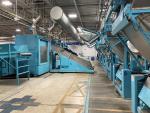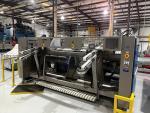CHICAGO — Factors such as quality, efficiency, safety and labor issues have pushed technological advances in industrial laundry technology in recent years.
These upgrades and advancements have been researched, tested and implemented by manufacturers of equipment throughout laundry processing facilities.
That includes the final phase of the operation: finishing.
American Laundry News reached out to operators and finishing equipment manufacturers to learn about recent advancements and the benefits they provide in the processing of goods.
How can operators best make use of these upgrades?
EDWARD MCCAULEY, president and CEO of United Hospital Services and a member of the American Laundry News editorial advisory board: QC cameras are so sensitive that you could literally reject 100% of your items or nothing at all, so the set-up process is the key. We like to set the cameras to give us about a 6% reject rate.
We can also tell the camera not to look at anything that is within 8 inches of the borders because stains or mends in this area are not as critical to the overall quality of the sheet.
These cameras can provide a quality level unmatched by your competitors.
AL ADCOCK, vice president of sales and marketing for B&C Technologies: The type of washer-extractor plays an important role in the productivity of the ironer. Soft-mount washer-extractors with extraction forces of 300-400 G-force will provide the optimum moisture retention to allow the ironer to run at high speeds while providing quality results.
Hard-mount machines with extract speeds of 200 G-force will require you to slow the ironer significantly or force you to condition the goods in the dryer prior to ironing. Double handling the goods in this way reduces the overall efficiency and productivity of your facility.
Be wary of high-speed hard mounts that claim to extract at 400 G-force. While the machines may occasionally reach these extract speeds, the problem lies with an extract speed that completely depends on the amount of imbalance in the wash cylinder prior to extraction. The problem with a varying extract is uncertainty in moisture retention, causing unpredictable results.
If the goods extract at 400 G-force, the ironer needs to run at a fast speed. Conversely, a 100 G-force extract will require much slower speeds. All of this will add up to confusion among the operators of the ironer since there is no good way to tell what the moisture retention is and at what speed to run the ironer for best results.
Speaking of the wash process, wash chemistry is of critical importance as incorrect pH levels, the use of softener, and inadequate rinsing will all show up and create problems in the ironing process. It is important to work with a chemical company representative who is familiar with setting up wash processes for ironing.
PAULO ROCHA, head of service U.S., regional service director NAM Region, Miele Professional: Operators should engage in thorough training sessions to fully understand the equipment’s capabilities. By familiarizing themselves with the upgraded features, operators can harness the full potential of the equipment to enhance their laundry operations.
Additionally, adherence to regularly scheduled maintenance and calibration procedures is crucial to ensure consistent performance and prolong the lifespan of the equipment.
Miele Professional stands by our commitment to customer support, offering assistance through our trained network of service technicians to address questions or issues that may arise.
CAROL TYLER, director of marketing for Chicago Dryer Company: Operators need to educate themselves on the technology and take advantage of training on the use and care of newer technology. With that, they will be able to gain the most from such a system.
Have operators requested other changes/upgrades? If so, what?
DAVID NETUSIL, sales support manager for JENSEN USA Inc.: Yes, a two-lane cornerless spreader/feeder and multi-lane small-piece automatic feeding.
Both are difficult to accomplish but not out of the realm of possibilities.
TYLER: Anywhere that is both possible and practical, operators are requesting further automation. It will be necessary to run as close to peak efficiency as possible. Automation can offer repeatability and reliability that can be hard to achieve manually.
In addition, the expansion of RFID technology to better manage linen and reject linen that either does or does not meet the required standards will likely be more widely used.
Are there any upgrades that will be coming soon? If so, what?
NETUSIL: JENSEN-GROUP is always innovating, so, the answer is yes. There are new designs in research and design and product development that will be unveiled in the coming days, but unfortunately, we cannot offer any details at this time. Stay tuned.
TYLER: There will be further upgrades along these lines that will expand upon automatically processing towels. That will include washcloths.
Plus, the ability to reject items from an automated system that were not properly sorted out in the soil sort area of the laundry.
Please share any other information you consider important for operators to know.
NETUSIL: The U.S. market is quickly catching up with the European market in terms of operator efficiency, ergonomics, and resource consumption, changing the laundry landscape for the better.
ADCOCK: Make sure to perform all scheduled maintenance on your ironer. This is the best way to protect your investment throughout its life.
Allowing critical maintenance steps to go by the wayside is the surest way to heartache as an ironer has many moving parts that must all work in concert together to perform the task at hand.
Planning for and performing maintenance is of the utmost importance if you expect to utilize your ironer to its fullest potential.
TYLER: Our industry is changing and evolving. Operators will want to embrace it, learn it and utilize it in the most efficient fashion possible.
But, it has to make sense for that particular operation. With the installation of the right system, the benefits can be realized.
Click HERE to read Part 1 on recent finishing equipment upgrades and the benefits to laundry operators.
Have a question or comment? E-mail our editor Matt Poe at [email protected].





